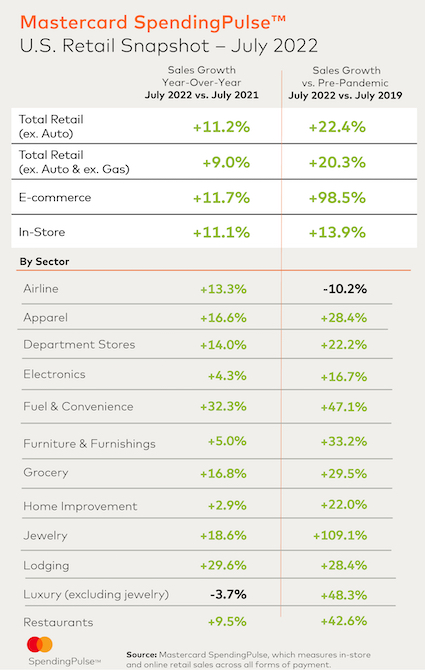U.S. grocery retail sales continued double-digit growth in July, climbing 16.8% year over year primarily due to food price increases, according to the latest Mastercard SpendingPulse report.
That’s 29.5% higher than in July 2019, several months before the COVID-19 pandemic turned the retail world upside down, according to Purchase, N.Y.-based MasterCard. This July was the fourth straight month that grocery posted double-digit retail sales gains, including 14% in June, 13.8% in May and 12.4% in April.
 Overall U.S. retail spending, excluding automotive, rose 11.2% year over year for July, and retail sales excluding automotive and gas gained 9%, according to the Mastercard SpendingPulse report, which measures in-store and online retail sales across all forms of payment.
Overall U.S. retail spending, excluding automotive, rose 11.2% year over year for July, and retail sales excluding automotive and gas gained 9%, according to the Mastercard SpendingPulse report, which measures in-store and online retail sales across all forms of payment.
E-commerce sales jumped 11.7% in July — a sharp increase after months of softer growth — and have nearly doubled pre-pandemic levels, up 98.5% versus July 2019. Major promotional events in July helped attract shoppers looking for online deals, Mastercard noted.
Higher demand and higher prices contributed to July’s spending increases, which outpaced monthly year-over-year growth so far in 2022, the Mastercard SpendingPulse report said. Fuel/convenience spending remains elevated, up 32.3% year over year in July and 47.1% from July 2019, though the growth rate is down compared with June’s 42.1% gain, reflecting lower prices at the pump.
Apparel (+16.6%) and jewelry (+18.6%) sales saw strong demand-driven, year-over-year growth for July, well outpacing sector-specific inflation. Travel also remains a priority, with lodging up 29.6% and airline sales up 13.3% for the month.
“The latest retail trends place an emphasis on consumer choice and passion-driven spending. They’re hunting for deals, shopping across channels and, ultimately, still spending on experiences and goods that make them feel good,” Steve Sadove, senior adviser for Mastercard and former CEO and chairman of Saks Inc., said in a statement. “As retailers grapple with excess inventory and supply chain constraints, it’s likely that the promotional activity seen in July will continue to be an important strategy for retailers.”
Other sectors seeing sales increases in July were departments stores (14%), electronics (4.3%), furniture and furnishings (5%), home improvement (2.9%) and restaurants (9.5%). Luxury (excluding jewelry) registered a decline of 3.7%.
The weakening growth in home improvement and furniture/furnishings sales reflects the concurrent slowdown in the U.S. housing market, which has cooled considerably from its busy pandemic levels, according to the Mastercard Economics Institute.
“Consumers’ purchasing power has been strained by higher prices, particularly for the most fundamental needs-based categories like food and energy,” explained Michelle Meyer, U.S. chief economist for the Mastercard Economics Institute. “Thus far, nominal spending remains strong as consumers cope with high price inflation. As we continue to look at the strength of the consumer, we will be keenly focused on trends surrounding employment and wage growth.”





